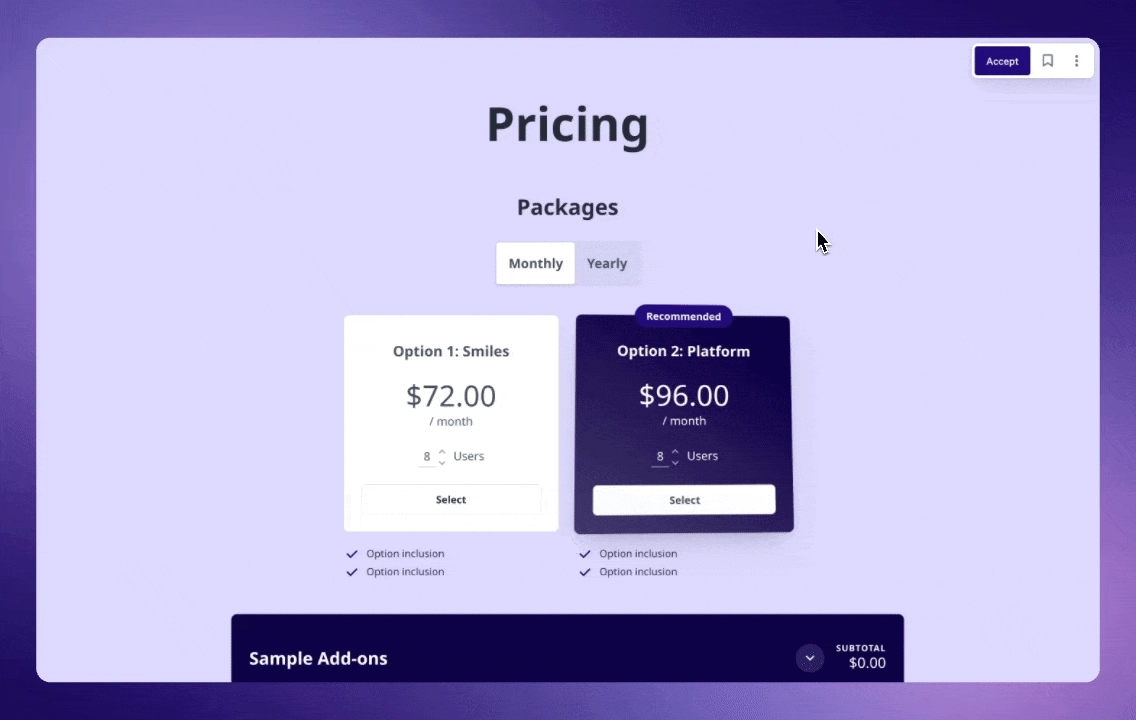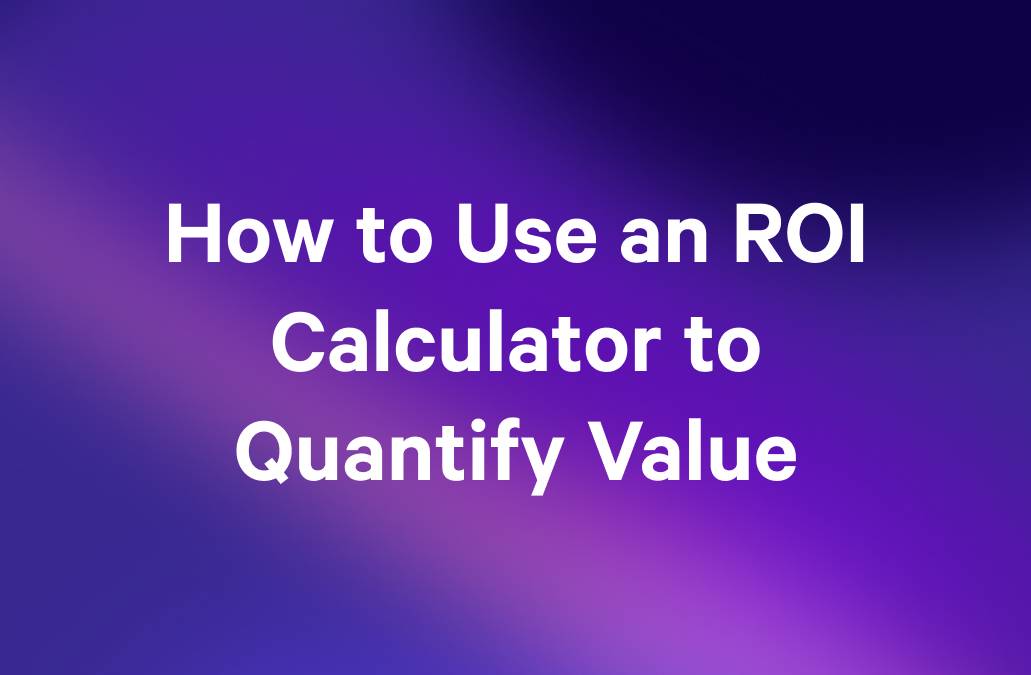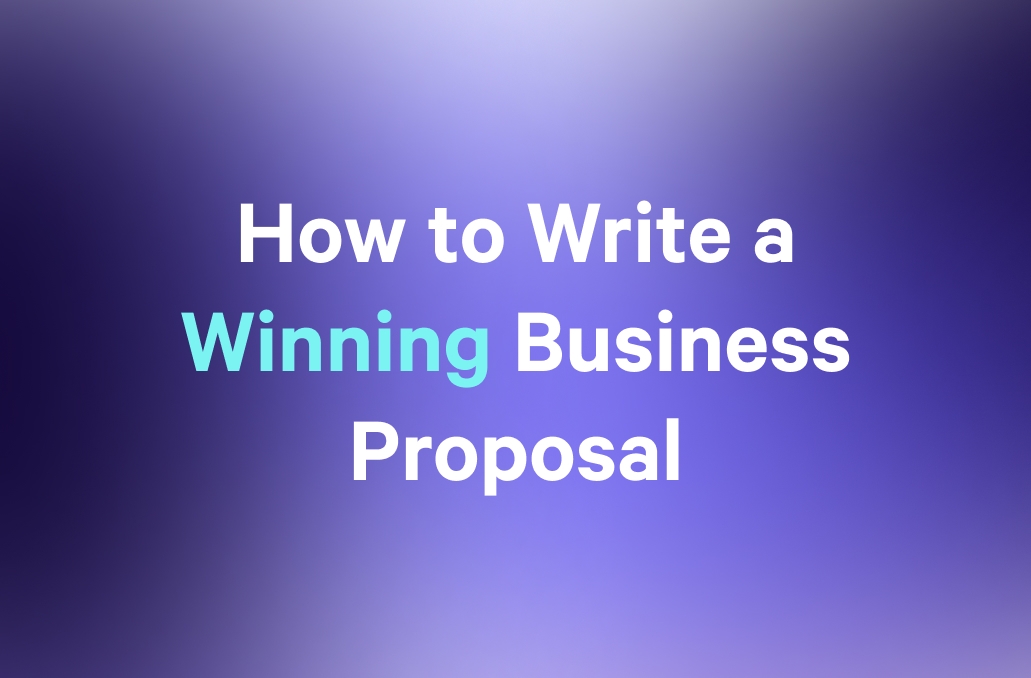In for a penny, in for a pound. According to a 2024 report, in 2023, the presence of Chief Product Officers (CPOs) in Fortune 1000 companies doubled from the previous year, rising from 15% in 2022 to 30%.
What does this rather sharp rise tell us? How product management is darn important in the ever-changing currents of the modern market.
At the core of every game-changing product launch is a finely-tuned product proposal, and, well, you see where we’re going with this…
Key takeaways
- Product proposals are essential for presenting ideas and outlining problems, solutions, and benefits to gain stakeholder support.
- Proposals vary by audience (e.g., B2B, B2C, investors) and must be tailored to specific needs.
- A title page, executive summary, problem, solution, implementation plan, financials, and a call to action are crucial features in a proposal.
- You can know your audience, define the problem, focus on benefits, and polish the document using tools like Qwilr for efficiency.
What is a product proposal?
A product proposal is a formal document designed to present a new product or solution to a specific audience, such as clients, investors, or stakeholders. It outlines the problem the product aims to solve, the proposed solution, its benefits, and how it will be implemented.
If you were looking for a motivational sign, this is it
Before we get to the ‘everything you need to know’ nitty-gritty, think about this:
Where would we be if Steve Jobs hadn’t pitched the idea of the iPhone as a revolutionary device that combines a phone, an iPod, and an internet communicator? What if Brian Chesky and Joe Gebbia hadn’t convinced investors that strangers would pay to stay in each other’s homes, giving rise to Airbnb? (And a new take on convenient traveling).
Innovators take pen to paper, and this is the result!
These groundbreaking ideas began as proposals, carefully crafted documents that turned imagination into reality. Drafting the proposal is first and foremost the most crucial step.
Back to the nitty-gritty.
Types of product proposals
For big thinkers, storytellers, and problem solvers, there’s a range of different product proposals that serve a specific purpose. Here they are:
1. Business-to-Business (B2B) Product Proposal
These are tailored for presenting a product or service to another company, often focusing on how it solves the client’s operational challenges or improves efficiency. The outcome? Mutual value - I scratch your back, you scratch mine!
For example: A SaaS company proposing a cloud-based project management tool to streamline a corporation’s workflow.
2. Business-to-Consumer (B2C) Product Proposal
B2Cs are geared toward persuading end consumers to adopt a new product by highlighting its features and emotional appeal. After all, consumers are the engine that keeps the economy moving!
For example: A proposal for a new fitness app that motivates users through personalized coaching and gamification.
3. Internal Product Proposal
Keeping it in the company, these are created to pitch a product idea to internal stakeholders, such as company executives or department heads, to secure resources, budget, or approval.
For example: An employee proposing an AI-powered customer support chatbot to the executive team to reduce response times and improve customer satisfaction.
4. Investor Product Proposal
Casting a wide net and opening the floodgates! These proposals are focused on attracting funding by demonstrating the product's market potential, solid scalability, and a booming return on investment.
For example: A startup presenting a wearable device that tracks hydration levels to a venture capital firm.
5. Partnership or Joint Venture Proposal
Two is better than one. These are aimed at forming a collaboration between two or more businesses, showcasing how the product complements the partner's offerings and creates mutual benefits.
For example: A proposal for a beverage brand to partner with a fitness company to develop co-branded health drinks.
6. Government or Nonprofit Product Proposal
If you’re into igniting social impact (while navigating the complex maze of bureaucracy) these proposals are designed to meet the specific needs or requirements of government agencies or nonprofit organizations - providing sustainable benefits to communities.
For example: A company proposing solar-powered street lights to a municipality to promote sustainability and reduce energy costs.
7. Client-Specific Product Proposal
Customizing for the client, these specific proposals are crafted to address the unique challenges or goals of an individual client, showcasing a highly tailored solution, and making the client feel special - because you’ve done the homework and you’re speaking their language.
For example: A marketing agency proposing a bespoke digital advertising campaign for a luxury hotel chain.
8. Concept/Product Development Proposal
There’s an inkling of an idea, and you have a starting point. This looks at early-stage product ideas, pitching concepts for development funding or collaboration. It often emphasizes innovation and potential market fit - testing the waters.
For example: An engineer pitching a prototype for a foldable e-bike targeting urban commuters.
9. Service-Based Product Proposal
Moving away from the material and into the performance, these proposals outline a service offering rather than a physical product, emphasizing its value. (And by the way, great perks of offering services? Less inventory and overheads, and deeper customer engagement.)
For example: A consulting firm proposing a leadership training program to enhance management effectiveness in a client’s organization.
10. Request for Proposal (RFP) Response
A formal request from an organization seeking a product or service has been sent out. Providing them with a solution is up for grabs. They’ve listed their specified requirements. Now you vouch you can get the job done.
For example: An IT firm responding to an RFP to provide cybersecurity solutions for a healthcare provider.
What to include in a product proposal
Creating a product proposal requires a clear structure that guides your audience through your vision. Here’s what to include and in simple terms, how to make it actionable. (You didn’t come here for a haircut…)
Title Page
Your title page sets the tone for your proposal. (And if you didn’t know already, you’re aiming for professional, confident, and persuasive!). Include the proposal title, your name, the company name, and the date. This ensures your document is easy to identify.
Pro Tip: Use clear, concise, and descriptive titles that immediately convey the purpose of the proposal, such as “Revolutionizing Team Productivity with AI-Powered Tools.” Ensure the design is clean and visually appealing to make a strong first impression.

Create a title page with Qwilr that stands out
Executive Summary
The executive summary is a brief overview of the problem, solution, and value. It’s your quick sell in written form. Keep it concise but impactful, as many decision-makers may only read this section.
Pro Tip: Write this section last, after you’ve completed the rest of the proposal. Use bullet points to highlight key takeaways and ensure your value proposition is clear and compelling.
Introduction
Use the introduction to set the context and introduce your company or product. Share a brief background, highlighting your credibility and experience. Your tone here should be upbeat! Show that you’ve got spunk.
Pro Tip: Incorporate a compelling opening statement or statistic to grab attention. For instance, “85% of teams report struggling with inefficient workflows. Our solution addresses this head-on.”
Problem Statement
Clearly define the issue your product addresses. Use data, anecdotes, and real-world examples to illustrate the problem and its impact on your audience.
Pro Tip: Frame the problem in terms of your audience’s pain points. Use phrases like, “Are you struggling with...” or “Imagine losing $2 million annually due to...” to make the problem relatable and urgent.
Solution
Cool, you’ve identified the problem. Now describe your product and its benefits. Explain how it solves the problem and creates value. Avoid technical jargon unless your audience is highly technical.
Pro Tip: Highlight specific features of your product and tie them to the problem. Use storytelling or analogies, such as, “Our software acts like a personal assistant, automating your repetitive tasks and freeing up your time for strategic work.”
Implementation Plan
Outline the steps, timeline, and resources needed to deliver the solution. Don’t be wishy-washy but rather transparent about what the process entails and how long it will take.
Pro Tip: Break down the implementation plan into clear phases, such as “Phase 1: Onboarding and Training,” and include specific dates or timeframes. This gives your audience confidence in your ability to execute.
Financials
Provide pricing, cost breakdowns, and sweet ROI estimates. Be transparent and detailed to help your audience understand the value of their investment.
Pro Tip: Use visuals like tables or graphs to present financial data clearly. Include a section that highlights the potential cost of not implementing your solution, reinforcing the urgency. Outline costs in a clear and interactive pricing table that prospects can engage with.

Interactive pricing tables and quote blocks are just a few of the engaging elements you can embed in your Qwilr proposals
Conclusion
Last but not least, summarize key points and include a compelling call to action. Here you want to come full circle, so reiterate the value of your solution and why it’s the right choice for your audience.
Pro Tip: End with a personalized thank-you and a next step, such as scheduling a meeting or signing an agreement. For example, “Thank you for your time. We’d love to schedule a call next week to discuss how we can get started.”

With Qwilr's integrated e-signature and payment functions, your prospects can accept, sign, and pay on one document
Appendices
Add the good stuff, like supplementary materials, case studies, technical specifications, meet the team, or visual mockups. The best part about this section is that it supports your main argument without cluttering the core content!
Pro Tip: Use appendices to address detailed questions that may arise. For instance, include FAQs or a glossary of terms if your audience is less familiar with the industry.

4 tips for writing a product proposal
Here are some things to consider when putting your pen to paper in your proposal.
- Understand your audience: Research deeply: Who are they? What challenges do they face? Speak their language by customizing your proposal to their needs and concerns.
- Define the problem clearly: Frame the problem as a ticking clock to create a subtle sense of urgency. Use data and anecdotes to make the issue relatable and compelling.
- Present your solution effectively: Highlight benefits, not just features. Show how your product impacts their lives or business. Use analogies and visuals to simplify complex ideas. And address potential objections with data or testimonials.
- Polish and perfect: The job ain’t done until you have rigorously proofread your proposal to eliminate errors. Remember, design matters: Use professional formatting and clean layouts, and follow strong product photography tips for polished visuals.
Close deals faster with dynamic pricing, e-sign, and payments. Start collapsing multiple steps in your sales process into one. Find out more.
Product proposal template
You don’t really want to spend time reinventing the wheel when there are already existing templates that have proven success rates.. You do want to absolutely nail the essence of your proposal and what’s most important the content.
Qwilr's Product Proposal Template is designed to effectively showcase your exciting product's value to potential clients or investors and gives plenty of room for customization. Here's an overview of its key components:
- The problem space: This section identifies the specific challenges or pain points that your target market faces. Clearly defining the problem establishes the relevance of your product and sets the stage for presenting your solution.
- The solution: Here, you detail how your product addresses the identified problem. Highlight its unique features and benefits, demonstrating how it stands out from competitors and meets the needs of your audience.
- Pricing: This component outlines your pricing strategy, including different packages or tiers if applicable. Transparent pricing helps build trust and allows potential clients to assess the value proposition effectively.
- Contact: Providing clear contact information ensures that interested parties can easily reach out for further discussion or clarification, facilitating seamless communication.
With customizable designs, you can match your brand’s colors, logo, and fonts for a polished, professional look. Interactive features like embedded videos and pricing tables bring your proposals to life. Plus, re
al-time engagement insights let you track recipient interactions, so you can refine your approach and follow up strategically.

Locking it in with Qwilr
A well-written product proposal is not just a document; it’s the bridge that connects your vision to your audience’s needs. Pitch to a potential client. Secure funding from investors. Convince internal stakeholders. Whatever it is that you need to do, Qwilr’s templates make for captivating, convincing, and compelling action.
For a glimpse into our world, sign up for a free trial to maximize what’s on offer.
About the author

Tania Clarke|Head of Product Marketing
Tania heads up product marketing at Qwilr – looking after positioning, sales enablement, competitor intelligence and more. Tania brings experience from former roles at high growth startups like Atlassian and Safety Culture.


